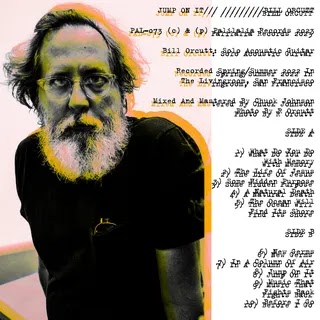On his first solo acoustic outing in a decade, the former Harry Pussy member shifts from deconstructing the guitar to reassembling it according to his own idiosyncratic design.
Bill Orcutt is an unlikely elder statesman of traditional American guitar music. Though he looks the part, with his professorial eyeglasses and John Berryman beard, his confrontational work with ’90s noise rockers Harry Pussy offered little indication of where he’d eventually end up. Harry Pussy called it quits in 1997, and then, after more than a decade of silence, Orcutt returned in 2009 with a set of frenzied improvisations for his four-string acoustic Kay guitar, summoning Lightnin’ Hopkins and Lightning Bolt in equal measure. Since then, he has carved out a niche for himself with deconstructions of the Great American Songbook, solo electric compositions, and Reichian exercises in counterpoint. Like any American master, Orcutt is too eccentric and unpredictable for direct comparisons. His influences are clear—the dissonant improv of Derek Bailey, the athletic fingerpicking of John Fahey, the ethereal spaciness of Loren Connors—but these points of reference outline a completely new constellation.
Orcutt’s early solo records consisted of cubist blocks of sound cascading from his guitar with the speed of late-game Tetris bricks. When he went electric in the middle of the last decade, his notes instead drifted down like snowflakes (though he still occasionally kicked them up into flurries). Jump on It applies this later, more mannered approach to Orcutt’s first solo acoustic outing since 2013’s A History of Every One. Its mic placement gives the impression that the listener is uncomfortably close to Orcutt, ears hovering somewhere between the body of his guitar and the collar of his shirt. His breathing is frequently audible, as is the squeak of his chair. For a guitarist whose frantic outbursts of noise could keep audiences at a distance, these 10 tracks, running just half an hour, offer an intimate glimpse into the minutely considered songcraft hidden within the bang and clatter of his technique.
Jump on It’s beautifully crafted miniatures are often somber even as they shimmer and gleam with natural reverb. Some tracks, like early standouts “What Do You Do With Memory” and “The Ocean Will Find Its Shore,” delicately unfurl into long, flowering tendrils of fingerpicked melody. The album’s second half becomes more dense and winding with “New Germs,” which grows from a tentative beginning into a dizzying swirl of notes backed by soft moans. Orcutt’s penchant for repetition—a constant in his work from before his solo debut through to his most recent album—appears here as well. “In a Column of Air” ends with a tornado of cyclical figures, while the entirety of “Music That Fights Back” is built from variations on a short repeating phrase. If the compositional approaches are not new, the clarity and patience with which they are carried out certainly is. Orcutt spent years deconstructing the acoustic guitar only to carefully piece it back together according to his own idiosyncratic design.
Jump on It is the easiest introduction to Orcutt’s sizable discography. As Charalambides’ Tom Carter says in the album’s liner notes, these tracks express a “conversational beauty that would please the most dissonance-adverse listener.” To longtime fans, that may suggest that the music has lost its edge, that it is less blazingly original than his early acoustic work. But careful listening reveals that the album’s welcoming facade is an invitation into a tantalizingly complex world, like a perfectly manicured hedge maze guiding you through concentric pathways.



0 comments:
Post a Comment